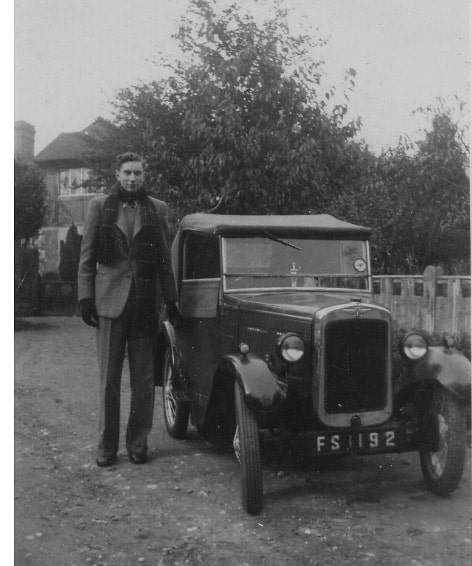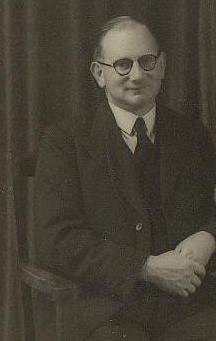
Photograph courtesy of Neville Carrington
We moved to Dorking in September 1940, during the Battle of Britain, when I was seven years old.
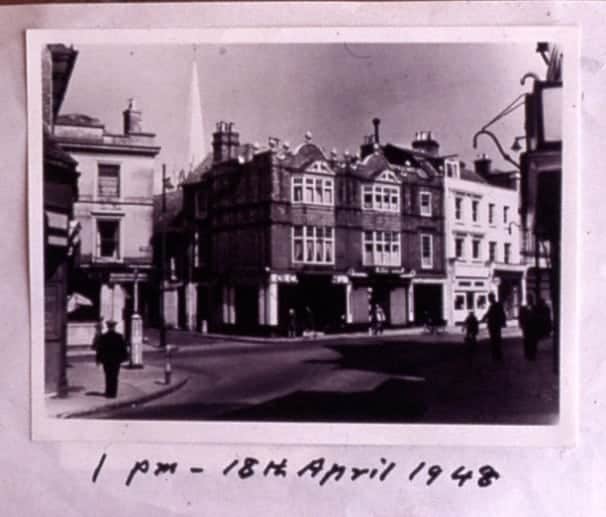
Photograph courtesy of Neville Carrington
Father bought the pharmacy at 5 High Street Dorking from Mr W M Nicholl. At the same time we took over the property Bradley Mead, Chichester Road, in a cul-de-sac now re-named Chichester Close. I think the house was initially rented, then purchased also from Mr Nicholl for about £2,000.
In the First World War, Father was a Private [Pioneer] in the Gas Corps and is recorded in The Times, March 1917 as wounded by being gassed. Read the article, which was written by my father soon after coming to Dorking when he was appointed Gas Identification Officer.
War Weapons Week 1941.
Father was keen on cine photography and below is an unedited copy of one of his cine films. This had actually been edited by Surrey History Centre who have a fair copy in their archives. The archivist told me that he was not aware of a similar record. The film can be viewed at Surrey History Centre (Accession number 9874). In the War Weapons Week shots, O.L.C. is at the front of the column on the left hand side of the picture. I am the small boy appearing momentarily during the parade.
For enhanced pictures, permission to publish or other information please contact J. Neville Carrington, via the Museum.
O.L.C’s Business Interests
5 High Street Dorking
My father appears to have paid £4,000 [£203,260 in 2020] for the goodwill of the pharmacy – which seems expensive for a business making a profit of about £1,100 per annum [£51,000 today] and with a lease of 14 years to run.
The corner premises at No. 1, High Street, Dorking became vacant in 1943 and my father took the lease to run to 1954, the end of the lease on 5, High Street. He joined the two buildings to make one shop and accommodated a manager in the flat above No. 1, using the space above No. 5 as storage, as his chiropody clinic, office, a laboratory and from 1952, a packing room for Liquifry.
About 1947, penicillin became available and sterile injections became more common. My father liked to be ahead of the field and he went on a course and subsequently he built a small laboratory with the special precautions which were necessary at the time for dispensing these items. Later these precautions became unnecessary as technology moved on.
Father was also qualified as a chiropodist and in the 1930s he also lectured at the London Foot Hospital. His book Materia Medica for Students of Chiropody was a standard for many years. His book is still listed on Google in 2020: Materia Medica For Students Of Chiropody By O L Carrington.
Ornamental fish were another of Father’s interests and in 1952 we jointly produced and marketed a product called Liquifry, a food for feeding baby tropical fish – which was the foundation of Interpet Limited which still has its head office at Glebelands Centre in Vincent Lane.
I think that O.L.C was more interested in this business and his other activities than in the pharmacy. After the War he was President of the Reigate and Redhill branch of the Pharmaceutical Society and he also became very much involved with the administration of Westpark and Longrove mental hospitals
It was in a room above No. 5 High Street, where we first employed two women to pack Liquifry.
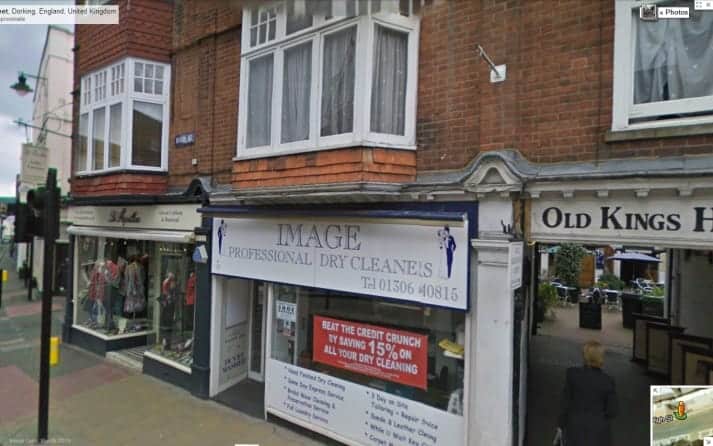
This is a very interesting building. The cellars go down two stories. In the lower cellar carved out of sandstone there are many old wine bottles. It may be the original Marquis of Granby mentioned by Charles Dickens in Pickwick Papers. The Kings Arms is another contender for the title.
The pharmacy in Dorking was probably at the time the most prominent independent one although they were at least four other pharmacies [Woodcocks, High Street and South Street; Boots and Firths at the Reigate end of High Street].
Like many chemists at the time, Father manufactured various unique products such as hand cream, which he packed exclusively for his shop[s].
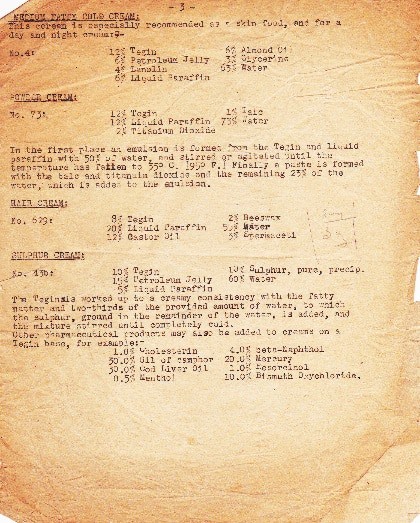
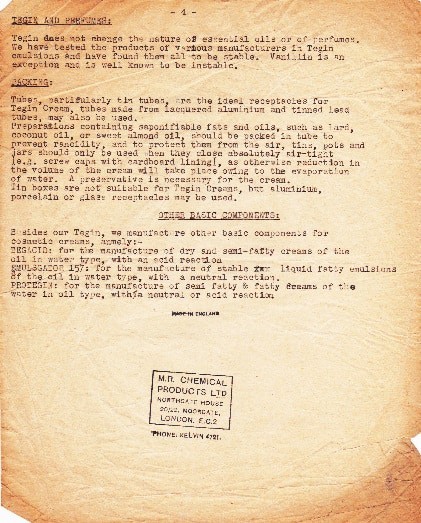
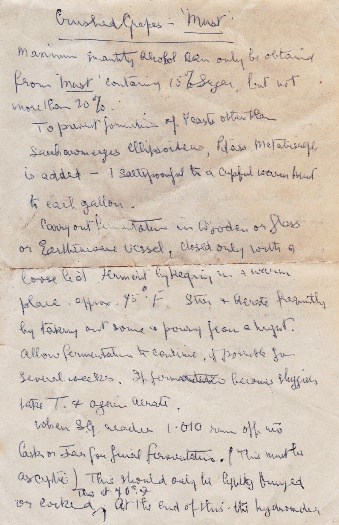
Examples of formulations made in the shops. Documents courtesy of Neville Carrington
In 1947 Father expanded by taking over the pharmacy at 300 London Road Croydon which I sold in 1968.
The lease on 1-5 High Street was due for renewal in 1954 and O.L.C chose not to renew, primarily I think I was more interested in industry and with no interest in retail pharmacy. I think pharmacy had always been a second choice for him. When he was discharged from the army at the end of World War 1 he was offered a place to study medicine in Edinburgh but he could not afford the course. Another factor might have been that he had his first heart attack in 1953. He was apparently offered to buy the whole block, which I think was owned by the Attlee family, for what seems now reasonable price of I think £15,000 [equivalent to £318,000 today].
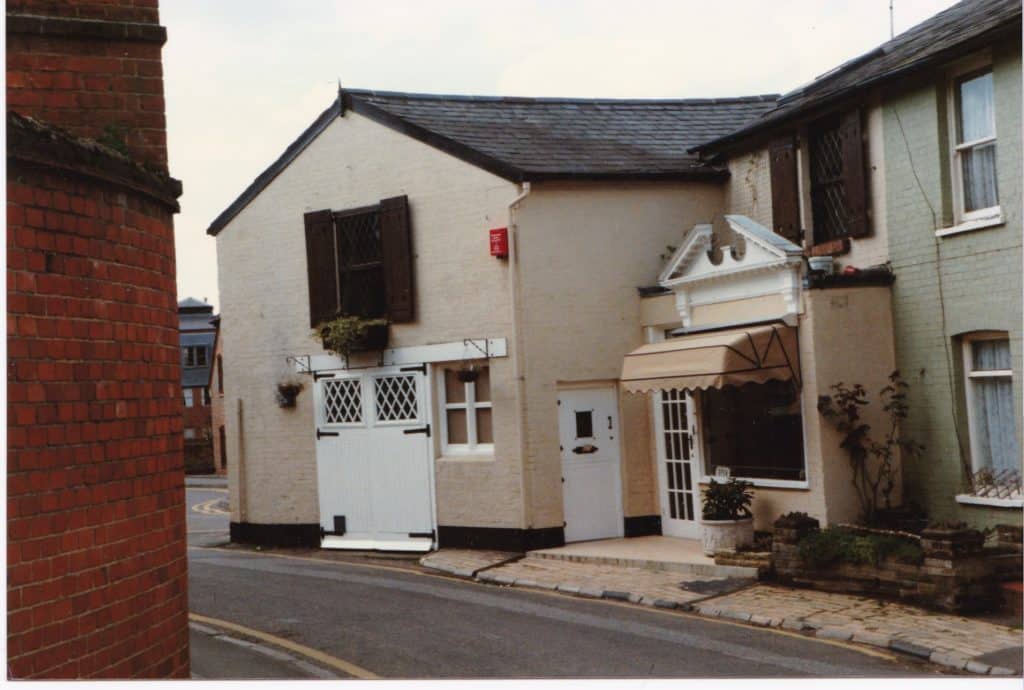
Photograph courtesy of Neville Carrington
We hired the small building at 18A Church Street from the Clear family and moved production of Liquifry to there. Subsequently we purchased no. 18 and 18A from the Clear family in 1958 After closing the Dorking shop, I’m not sure why Father took over a shop at 205 Fir Tree Road Epsom Downs, which I sold in August 1964.
A Dorking Resistance Group?

Photograph courtesy of Neville Carrington
Soon after arrival in Dorking father was given out the title of Gas Identification Officer, which apparently involved night time manoeuvres the importance of which may be indicated by his being allowed to keep his car running throughout the war. Presumably his experience in the gas corps in World War 1 supremely qualified him for this role. I believe he was given at the rank of Major. In 1965, when my mother moved to a smaller house and we cleared the garage loft, we found phials of poison gas and the bomb disposal squad collected them. There was also a revolver and live rounds which we handed to the police.
I believe there was a substantial resistance organisation based near Dorking and I recently found some information about the Auxiliary Units in South East England, and there was a major unit 8 miles away in Kingswood.
At the age of 8, I heard all sorts of things from my shelter in the fireplace in the dining room. Apparently, my father had a very good sense of direction in the dark. One night I heard him tell my mother that the leader of his group was a woman who was a genius at disabling weapons despite having long fingernails. On another occasion he said that he had been driving about with a bomb in the boot of his car.
In Autumn 1953 one of our neighbours, Sir Edward Raeburn, met me off my usual train and it was a moment before I realised that he was telling me that my father had a heart attack and that the ambulance was waiting for me at our house, about 5 minutes away, to go with him to Reigate hospital. My father had been up to London, he was taken ill on the train and was found by Jacques Luntz, the French teacher at Belmont, my prep school, then situated in Westcott. Father was 56 at the time, he died of a second attack ten years later. In autumn 1962 my father was breathless and had chest pains. He walked out of his shop and up Rose Hill almost opposite to see Dr Kellet-Carding at his surgery. He was immediately told to go home to bed. A cardiac consultant who also lived near us in Chichester Road came to see him soon afterwards and I believe told him to take it easy. This appears to have been to the extent of cardiac treatment at that time.
Fortunately I was at home on Thursday night March 14th 1963 and my father died during the night on March 15th. He was cremated in Crawley crematorium his ashes were buried in a grave space in Chipping Norton cemetery.

